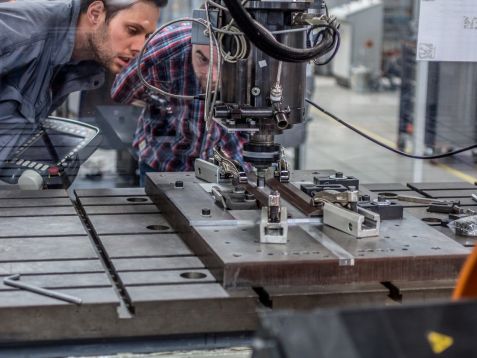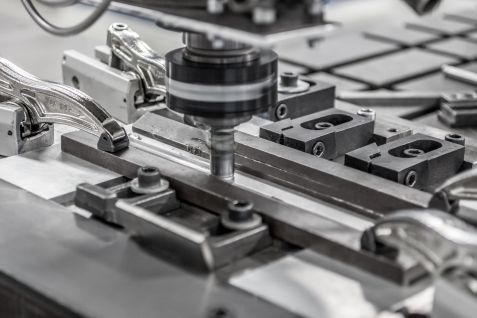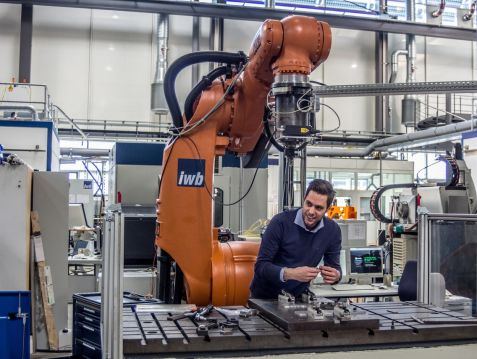MLZ is a cooperation between:
 > Technische Universität München
> Technische Universität München > Helmholtz-Zentrum Hereon
> Helmholtz-Zentrum Hereon
 > Forschungszentrum Jülich
> Forschungszentrum Jülich
MLZ is a member of:
 > LENS
> LENS > ERF-AISBL
> ERF-AISBL
MLZ on social media:

MLZ (eng)
Lichtenbergstr.1
85748 Garching
29.03.2021
Strong weld joints for aerospace applications

Dr. Andreas Bachmann (left) watches through a safety glass as the robot welds two metal plates together with the rapidly rotating welding pin. © Giacomo Costanzi / TUM
When a rocket is launched, the weld seams on the enormous fuel tanks must withstand immense forces. To produce joints with the necessary strength, a process known as “friction stir welding” is used. Scientists at the Technical University of Munich (TUM) are working to make this process more efficient. They are using positrons generated by the Research Neutron Source Heinz Maier-Leibnitz (FRM II) to precisely localize “atomic holes” in the material.
The friction stir welding process is increasingly common in applications requiring particularly strong and leakproof joints such as aircraft fuselages, automotive cooling systems or rocket fuel tanks. In contrast to other welding processes, friction stir welding requires no additional consumable materials and temperatures generally remain below the melting point of the workpieces. Consequently, the process is especially suitable for heat-sensitive materials such as aluminum.
Once the workpieces are clamped in place, the rapidly rotating welding pin is moved along the joint between the materials. The pin softens the material through frictional heat without melting it. While moving forward, the pin intermixes the two workpieces at the joint, producing a strong joint after cooling.
The problem with this process, invented just 30 years ago, is a lack of empirical data. With every new component and material, the equipment setup needs to be redefined through trial and error. An automatic control system that would select and adjust the settings itself would enormously improve the efficiency of the process. With that goal in mind, Dr. Andreas Bachmann has developed a control concept in his research work at TUM.

In friction stir welding, the rapidly rotating welding pin dips into the joint surface of two components and stirs them together. © Giacomo Costanzi / TUM
Positrons detect “holes” in metal
Bachmann began by working with a special aluminum alloy used in aerospace applications to analyze the influence of temperature and welding speed on the process. To do so, he used NEPOMUC, the world’s most intense positron source, at the Research Neutron Source Heinz Maier-Leibnitz (FRM II). “Using coincident doppler-broadening spectroscopy (CDBS) we were able to find flaws in the metal in and near the weld joint,” says Bachmann.
In the CDBS method, the researchers fire positrons into the metal lattice. There they are repelled by positively charged atomic nucleii and find their way into vacancies (“holes”) where they meet their antiparticle, the electron. This results in electron-positron annihilation and the creation of energetic photons. The measurements of the detected photons provide information on the position and frequency of atomic vacancies.

Dr. Andreas Bachmann prepares the component for welding. A universal industrial robot arm can be seen in the background with the mounted welding pin. © Giacomo Costanzi / TUM
Defects are linked to temperature
Fewer defects at higher welding temperatures of around 500°C were detected. “However, 500°C is still very low compared to other welding processes,” says Bachmann. “That shows: a lower welding temperature is naturally better for these temperature-sensitive materials. But if it is too low, however, it has a negative impact on the strength of the weld.” The ideal welding temperature may differ for other materials and must be determined on a case by case basis.
Bachmann has used these insights to develop a control for setting the optimal temperature. A sensor measures the temperature in real time. An algorithm determines how fast the tool needs to rotate so that the deviation between the target and actual values is 0. “Using the control, a weld joint was 1.5 times stronger in the test than without it,” says Bachmann.
He also showed that it would be theoretically possible to regulate the welding process without additional temperature sensors by measuring the resistance to the rotating welding pin to determine the temperature. “The hotter the metal, the easier it is to shape it — or stir it with the tool,” says Bachmann, who is now working in industry. “We can measure how easy or hard it is to stir the metal via the mechanical load on the spindle, i.e. the motor, driving the tool.” This approach could be refined to make it easier to use this control method in industry.
Original publication:
Bachmann, A.; Gigl, T.; Hugenschmidt, C. P.; Zaeh, M. F.: Characterization of the microstructure in friction stir welds of EN AW-2219 using coincident Doppler-broadening spectroscopy. In: Materials Characterization 149, (2019) o. Nr., S. 143 – 152.
DOI: doi.org/10.1016/j.matchar.2019.01.016
Contact:
Prof. Dr. Christoph Hugenschmidt (Verantwortlicher für Positronenquelle NEPOMUC)
+49 (0)89 289-14609
christoph.hugenschmidt@frm2.tum.de
Dr.-Ing. Andreas Bachmann
andreas.bachmann@iwb.mw.tum.de
MLZ is a cooperation between:
 > Technische Universität München
> Technische Universität München > Helmholtz-Zentrum Hereon
> Helmholtz-Zentrum Hereon
 > Forschungszentrum Jülich
> Forschungszentrum Jülich
MLZ is a member of:
 > LENS
> LENS > ERF-AISBL
> ERF-AISBL
MLZ on social media:


